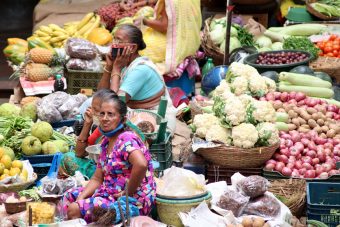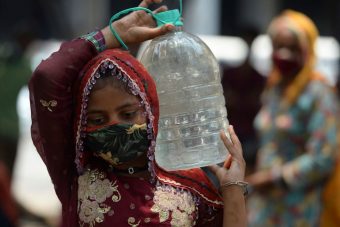


By Raihana Maqbool
Shaheena Jan walks along a rough road from her home to reach the main street that leads to the hospital, where she is working as a part-time sweeper in a government hospital in Shangus, Anantnag in South Kashmir.

By Priya Mirchandani
The elderly lady stares unseeingly ahead, lying in her hospital bed in Pune’s leading private hospital. She knows she’s lucky to be in a room with an oxygenated bed, but she can’t help but wonder how many roommates she will continue to outstay in this heavily guarded COVID isolation wing.

By Swati Sanyal Tarafdar
Every morning, 40-year-old Mahalakshmi (not her real name) wakes up at 5 a.m. and quickly gets ready for work as a sanitation worker. She pulls on her uniform—a light blue knee-length cotton shirt—over a red and green synthetic saree.

By Sara Bardhan
As the COVID-19 pandemic continues to batter India, states have imposed lockdown restrictions and curfews in an attempt to reduce the spread of the deadly virus. For transgender people across the country, the rules can mean being trapped in hostile homes and without access to the community, medical care, and mental-health services that they depend on for survival.

By Fahad Shah
Hours before her night shift at the hospital, when 32-year-old nurse Rakhi John received a call from her father she burst into tears. Her grandmother, who raised her since she was one, had succumbed to COVID-19 at her home in the south Indian state of Kerala.

By Sarita Santoshini
In Azamgarh district of Uttar Pradesh, 55-year-old Gyanwati Devi quickly stops by the home of her supervisor in the evening to collect medicines. Earlier in the day, she visited 50 village households for a survey of people showing symptoms of illness, carefully noting down their names and advising them what to do.

By Dharani Thangavelu
Devi has been on the phone all morning. She’s called contractors, masons and friends to see if they have work for her tomorrow. But so far, no luck. Tomorrow she will try again.

By Chryselle D’Silva Dias
For Diana*, it’s déjà vu all over again.
After a 3-day partial lockdown, the state is back to business with “restrictions.” Casinos are closed until May 10, hotels remain open as there is no ban on tourists and restaurants are open with 50% seating capacity or for takeaways only.

By Sonal Kellogg
Taramani Devi, 43, has been infected with coronavirus three times—and recovered from it three times—while battling kidney failure. The last time she was infected COVID-19, it was two days after she had undergone a surgery for a kidney transplant, when her husband Gangadhar Singh donated a kidney to his wife.

By Raihana Maqbool
Wearing a Kashmiri pheran and a white scarf wrapped on her head, Fazi Begum, calls out customers loudly to buy fish from her so that she can sell all her stock before dusk.

By Nayanika Guha
Akanksha*, 22, a final-year law student from Tamil Nadu, says she was always “on call” at home while taking care of her father for two months while he recovered from COVID-19 in June and July last year.

By Anika Nayak
Aditi, 37, bought Remdesivir, an antiviral medication currently authorized for COVID-19 treatment in India, from the black market in Delhi for her father who has been on a ventilator in the ICU for four days.

By Varsha Bansal
On the afternoon of April 6, Pramila Devi Kol, 26, went into labor. Her husband, Sajjan Kumar Kol, dialed the emergency helpline 108 to call an ambulance to get her to the hospital in time for the delivery.

By Riddhi Dastidar
On April 18, as India’s national capital was running out of hospital beds, and Twitter was flooded with #SOSDelhi tweets that would soon become familiar, college freshman Anuradha Malik, 18, saw an Instagram story linking to a volunteer form. The next day, as Delhi went into lockdown again, she was added to a Whatsapp group.

By Romita Saluja
Surbhi Das began to feel that India was losing control of COVID earlier this month when seven of her colleagues and three patients tested positive for the virus. She worked in the COVID ward of All India Institute of Medical Sciences, Rishikesh for three months last year but, Das says, the situation at the hospital is 10 times more severe now.

By Chryselle D’Silva Dias
At the Panjim Market in Goa, local vendors like Tulsi, 55, seem unconcerned about the second wave. Sitting on an elevated platform under the soaring roof of the market, she’s surrounded by piles of mangoes and steel cups full of shiny black local berries.

By Sarita Santoshini
Preeti Namjoshi, a 26-year-old resident doctor in the final days of her three-year masters’ degree in internal medicine, was supposed to be preparing for final exams right now. Instead she finds herself struggling to assist with the surging number of people sick and dying from COVID-19 at Government Medical College and Hospital in Nagpur.

By Mahima Jain
It’s noon and Asha Mutha, 53, has just finished cooking lunch. She wipes the sweat off her forehead, pushes the thick frames of her spectacles up the bridge of her nose, and tucks the pink viscose sari around her hip.
by Sara Bardhan
May 10, 2021
Editor’s Note: This feature is part of The Fuller Project’s ongoing series, Gasping For Breath: Women Provide A Glimpse Into India’s COVID Disaster. Read the full series here.
by Fahad Shah
May 6, 2021
Editor’s Note: This feature is part of The Fuller Project’s ongoing series, Gasping For Breath: Women Provide A Glimpse Into India’s COVID Disaster. Read the full series here.
by Sarita Santoshini
May 5, 2021
Editor’s Note: This feature is part of The Fuller Project’s ongoing series, Gasping For Breath: Women Provide A Glimpse Into India’s COVID Disaster. Read the full series here.

Plus insights from our leadership on the state of women in media, behind-the-scenes exclusives from our newsroom, and so much more.
